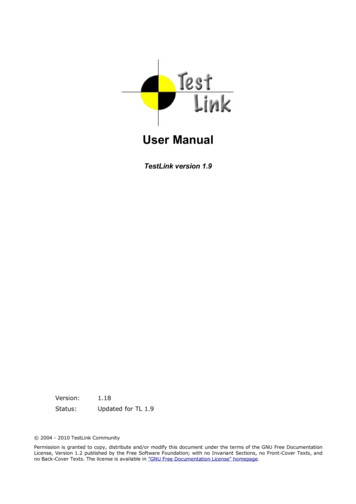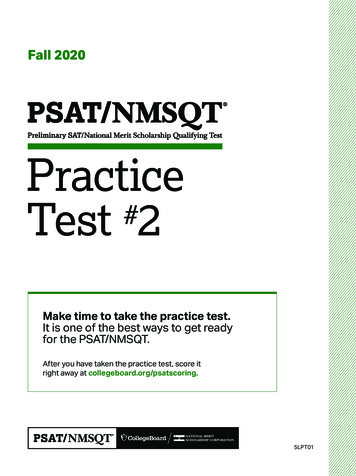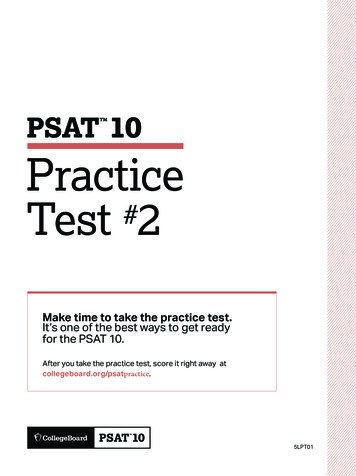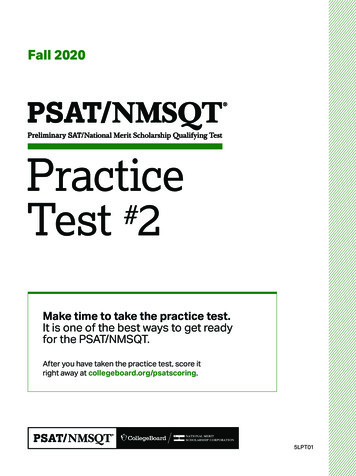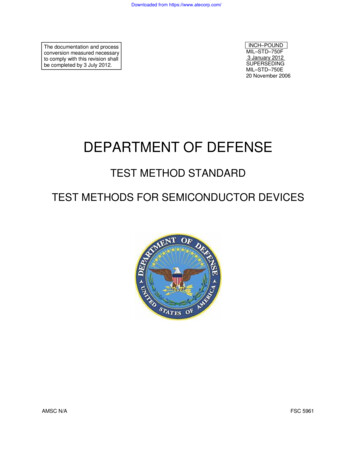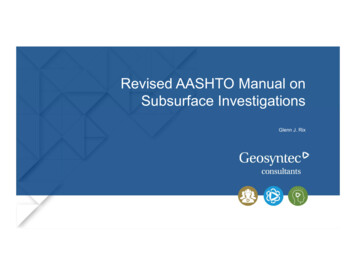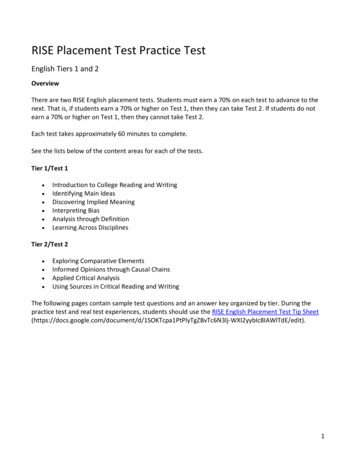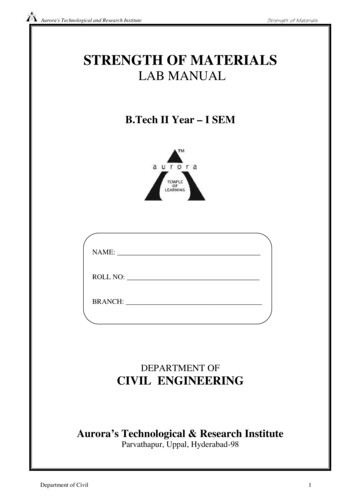
Transcription
Virtual Experience Test: A Virtual Environment Evaluation QuestionnaireDustin B. Chertoff *Brian Goldiez †Joseph J. LaViola, Jr. ‡Intelligent Automation, Inc.University of Central FloridaUniversity of Central FloridaABSTRACTWe present the development and evaluation of the VirtualExperience Test (VET). The VET is a survey instrument used tomeasure holistic virtual environment experiences based upon thefive dimensions of experiential design: sensory, cognitive,affective, active, and relational. Experiential Design (ED) is aholistic approach to enhance presence in virtual environments thatgoes beyond existing presence theory (i.e. a focus on the sensoryaspects of VE experiences) to include affective and cognitivefactors.To evaluate the VET, 62 participants played the commercialvideo game Mirror’s Edge. After gameplay both the VET and theITC-Sense of Presence Inventory (ITC-SOPI) were administered.A principal component analysis was performed on the VET and itwas determined that the actual question clustering coincided withthe proposed dimensions of experiential design. Furthermore,scores from the VET were shown to have a significantrelationship with presence scores on the ITC-SOPI. The results ofthis research produced a validated measure of holistic experiencethat could be used to evaluate virtual environments. Furthermore,our experiment indicates that virtual environments utilizingholistic designs can result in significantly higher presence.KEYWORDS: Presence, Experiential Design, Virtual EnvironmentsINDEX TERMS: H.5.1 [Information Interfaces and Presentation]:Multimedia Information Systems – Artificial, augmented, virtualrealities; H.5.1 [Information Interfaces and Presentation]:Multimedia Information Systems – Evaluation/methodology1 INTRODUCTIONThe experience users have in a virtual space emerges due to acombination of factors. For example, exogenous factors providethe context for a space through the physical and task environment[33]. As a result, the physical environment produces a state ofimmersion and the task environment can produce a state ofinvolvement. The interaction of these components is associatedwith the traditional sense of presence, or “being there,” in a virtualenvironment (VE). We use the term VE to represent the combinedhardware platform, software systems, and encountered scenarios.These early models of presence [14][22][37] have largelyemphasized the sensory components of experience. Inherent inthese models is the belief that a user decision towards the sensorycontent of a VE indicates that the user became present in that VE.This implies that increasing the sensory fidelity of the VE, be it*e-mail: dchertoff@i-a-i.com†e-mail: bgoldiez@ist.ucf.edu‡e-mail: jjl@eecs.ucf.eduthrough the addition of more senses into the experience or throughrefining a particular sensory channel, is enough to make a persondecide to continuously attend to the virtual environment.However, recent work involving entertainment virtualenvironments showed that while study participants desired a highsensory experience, such an experience was “irrelevant ‘eyecandy’ if the game was not enjoyable” [8]. This notion isenhanced if we think of an experience in the real world. Thereexist affective and cognitive elements, or endogenous factors, thatcontribute to a holistic experience beyond the physical locationand the tasks performed. There is much emerging support withinthe literature for a relationship between presence and holisticexperiences [7][10][17]. In fact, several researchers have begun tolook towards commercial video games to better understand howpresence is affected through holistic virtual environments[4][8][19][27]. Researchers have also looked at a sense of flow, ordeep involvement, with a virtual environment and immersion[6][13][35].These recent studies indicate that understanding the factors ofoverall experience are important for designing better VEs. Onepromising technique for incorporating overall experience intopresence is experiential design (ED) [7]. Experiential design is adesign philosophy where various dimensions of experience –sensory, cognitive, affective, active, and relational (see Table 1) –are considered in order to produce a desired user experience [28].This type of design philosophy has strong roots in the usercentered design ideas of [5][26].In this paper, we introduce a new survey instrument forevaluating the degree a VE incorporates the dimensions ofexperiential design. This instrument is known as the VirtualExperience Test (VET). The goal of the VET is allow designers toevaluate what aspects of experience their VE needs further workon, such that future iterations can be improved.In the next section we identify related work on measuringexperience in virtual environments. Section 3 reviews the conceptof experiential design. Section 4 discusses the development of theVET. Section 5 describes the experiment conducted to evaluatethe VET. We present the results of the experiment in section 6. Adiscussion of the experimental results is in section 7. Future workcan be found in section 8. We conclude in section 9.2 RELATED WORKThe measurement of presence originated with the use ofquestionnaires regarding the sensory experience of the user. TheSlater-Usoh-Steed (SUS) questionnaire consists of six questionsthat look at three themes to identify a sense of physical presencein an environment [34]. The three themes include: the user’s senseof being in the virtual environment, the extent to which the virtualenvironment becomes the user’s primary environment, and theextent to which the virtual environment is remembered as anactual place. The Witmer-Singer Presence Questionnaire (PQ)attempted to look beyond just immersion to measure userinvolvement as well [37]. The ITC-Sense of Presence Inventory(ITC-SOPI) also looked at the subjective sense of physicalpresence in addition to other factors related to engagement,ecological validity, and negative effects felt by users in VEs [21].
Table 1. Dimensions of experiential design applied towards virtual environments [7]Experiential Design DescriptionIncludes sensory input (visual, aural, haptic, etc.) as well as perception of those stimuli. Representedthrough sensory hardware and software that creates the sensations.Mental engagement with an experience, such as anticipating outcomes and solving mysteries. Canbe interpreted as task engagement.Refers to the user’s emotional state. Related to the degree to which a person’s emotions in thesimulated environment would accurately mimic his emotional state in a similar real-world situation.Relates to the degree of personal connection a person feels to an experience. Associated with thedegree of empathy, identification, and personal relation a person feels to the virtual environment’savatars, surroundings, and scenario.Comprised of the social aspects of an experience. Operationalized as co-experience; creating andreinforcing meaning through collaborative experiences.The SUS and PQ were amongst the first widely used presencequestionnaires. However, it was noted in [36] by the SUSdesigners that neither SUS nor PQ could pass a “reality” test.Both the PQ and SUS failed to produce significantly greaterpresence scores for a person in a real environment than in a virtualone. It was also found by [38] that a lack of reliable statisticalvalidity exists in both the SUS and PQ questionnaires. As a result,researchers have begun measuring causes associated withtemporary breaks in presence [32] and whether physiologicalreactions can be associated with presence [25].While such measures appear promising, they can becomplicated to administer, invasive, and subject to ambiguity.This has led other researchers to evaluate what contributes toexperience within high quality commercial video games. Thisclass of VE is consistently labelled highly immersive andinvolving by users, and could be enlightening on how to designmore effective traditional VEs.Examples of game experience evaluation include theGameFlow heuristics [35] which evaluate player enjoyment ingames. GameFlow was subsequently converted into aquestionnaire in order to evaluate e-learning game environments[13]. The Game Experience Questionnaire (GEQ) has also beenproposed by [19]. The GEQ is based on seven components ofgame-play experience: immersion, tension, competence, flow,negative affect, positive affect, and challenge.Further evidence for looking at evaluations of user experiencewith game environments comes from the Heuristics forEvaluating Playability (HEP) [11]. The HEP was developedaround four categories: game play (problems and challenges forthe player), game story (plots and character development), gamemechanics (rules), and game usability (interface and interactionmethods). The authors found that many of the issues found duringin-depth user evaluation were also uncovered by the HEP [11].With issues surrounding the validity of two existing majorpresence questionnaires, it appears constructive to furtherinvestigate alternative presence evaluation techniques.3 EXPERIENTIAL DESIGNIt was suggested that virtual environments be designed with auser’s holistic experience in mind [7]. The aim is to integrate thevarious elements of experience – sensory, cognitive, affective,active (personal), and relational (social) (see Table 1) – in order toelicit an enhanced sense of presence and to create situations whereaccurate, memorable, and stable schema can be developed. Theprocess of using these dimensions to create such an experience isknown as experiential design (ED) [28].ED originated from the marketing field where it was used toencourage people to create meaningful emotional and socialconnections to a product. For example, a person might construct apersonal narrative about an experience in a coffee shop listeningto live music on a couch. While the product being sold is coffee,the use of music and a homey environment creates a morecompelling environment. The person will subsequently createepisodic memories about the experience, and if they enjoyed theartifacts of that experience, will build positive associations withthe product being sold [3].Because of its reliance on positive associations stored inmemory, a cornerstone of ED is considering how prior, similarexperiences can be integrated into new user experiences. This ideais based on the self-referencing effect of cognition [23]. As weencounter new information, we attempt to relate it to experiencesstored in memory. Each query triggers a variety of associatedmemories to be remembered. Thus, a strong memory of anexperience can be recalled at a later time when the correct triggeris provided. For example, if our customer hears the same song shemight be reminded of the positive experience she had drinkingcoffee at our shop.VEs can also make use of this aspect of cognition. When a VEis designed to trigger a corresponding user experience, a variety ofmissing information can fill in the gaps left by the VE. This hasthe potential side-effect of increasing the user’s sense of presence[31]. By using holistic designs, the opportunity to both trigger aresponse from and to store experience in a potentially largernetwork of schema. This could increase the potential forperformance increases, a connection sought after by previouspresence researchers [2].4 VIRTUAL EXPERIENCE TESTDevelopment of the Virtual Experience Test began by creating aseries of heuristics based upon the experiential design dimensiondescriptions. From the sensory dimension, we determined that theheuristics should focus on the consistency and quality of sensoryinformation. From the cognitive dimension, heuristics thatassessed the ability to complete a task and to understand theenvironment’s rules were created. Heuristics from the affectivedimension measured the strength and variety of emotion towardsthe environment. The active dimension heuristics consisted of theability to become the avatar in the environment, the use of story toexplain the environment’s content, and the ability to reuse skillsthroughout the environment. Heuristics from the relationaldimension would measure the quality of interactions with agentsand other users. After the initial heuristic categorization, furtherrefinements were made to capture previously identified
associations with presence factors. These associations are nowexplained further.The sensory dimension consisted of seven heuristics regardinghow well the senses were utilized during interactions with the VE.A review done by [20] showed that both the quality of sensoryhardware and the sensory content had a widespread positive effecton reported presence. Thus, heuristics were included to addresssensory hardware and content quality. In addition, the consistencyof sensory information is rated.The cognitive dimension produced five heuristics. Theseheuristics focused on how well the environment supported taskengagement through the clarity of task explanations, perceivedtask interest, explanation of environment rules, and the ability ofthe environment to support multiple solutions for a task. The basisfor these heuristics came from the identification of variousenvironmental control factors shown to affect presence[18][30][37] and their similarity to the flow experience [9].The affective dimension contained four heuristics. Theseheuristics focused on the expected emotional impact of the usertowards the included scenarios. This included the variety,strength, and relevance of emotions experienced while completingthe scenarios. This set of heuristics also looked at how theenvironment conveyed desired user emotions through dialog, nonverbal cues (i.e. through agent postures and facial expressions),and audio. A relationship between presence and a high sense ofarousal [14][15][25], as well as between high user enjoyment andhigher reported presence [1] have been shown, lending support forthe impact of the affective dimension on presence.The active dimension also consisted of four heuristics. Theseheuristics were concerned with the expected level of userattachment towards the VE. Attachment was defined as the degreeto which the user would think they were a character in theenvironment, the level of content reuse, and the utilization ofnarrative. A compelling argument for presence beingfundamentally tied to agency and environment control has beenmade [16]. Further, there is support that narrative based virtualenvironments have an impact on increased presence [24].The relational dimension contained four heuristics. Theseheuristics were concerned with the social aspects of theenvironment. They focused on the expected level and quality ofuser interactions with agents in the environment. Previousresearch had shown that presence in social situations was higher,be it with agents, strangers, or friends [14][29].Based upon these identified associations, it was hypothesizedthat evaluating a VE using the heuristics would allow forpredictions to be made regarding how presence inducing theenvironment would be. An iterative process was then employed toconvert the list of heuristics into a questionnaire. Each questionwas rated on a 5-point Likert scale, with a 1 indicating “stronglydisagree” and a 5 indicating “strongly agree.” Two participantsfamiliar with gaming and virtual environments, but not the theorysurrounding presence and experiential design, were asked to pilotthe questionnaire. These participants were asked to explain whatthey thought each question was asking and to identify anyunfamiliar terminology, or that they thought would be unfamiliarto a novice. Suggestions by the participant were noted and used inthe next iteration of the questionnaire. The resulting questions canbe found in the first column of Table 2. The second columncontains the question’s associated dimension of experientialdesign. The third column contains the grouping established afterquestionnaire analysis was completed. The details of this columnare explained further in section 6.Figure 1. Exploring the world of Mirror’s Edge5 VET EVALUATIONAlthough the VET was heavily based on existing presence andexperiential design theory, it still required validation to ensurethat the chosen questions adequately related to their proposeddimensions. A study was therefore designed to investigate thevalidity of the VET. If the proposed questions and dimensionswere in fact valid, then it would also be necessary to determine ifthe VET could predict presence in different VEs. To ensure theVET was capable of doing so, an existing VE that incorporatedthe dimensions of experiential design in different configurationswas needed. To this end, the commercial game Mirror’s Edge was selected, as it contained two game configurations that utilizedthe dimensions of experiential design in different ways. If theVET was capable of predicting presence, then differences on theVET scores for each game configuration would also be reflectedin differences on presence scores. This question formed the basisof the study explained in the rest of this section.5.1 MethodologyIn Mirror’s Edge the player takes control of a character that runs,jumps, and climbs around various rooftops and interiors from afirst-person viewpoint [12]. The character’s arms and feet werevisible when the player moved around (see Figure 1). With itsfocus on exploring and interacting, Mirror’s Edge provided asimilar experience to traditional egocentric, walkthrough stylevirtual reality systems. In addition, there was a strong storycomponent to the world, which made it a good hybrid betweentraditional virtual reality and gaming.Mirror’s Edge included two game-types. The first game-typewas a story-mode. This game mode included a narrative andadditional characters that the player interacted with. The secondmode was a time-trial mode, where the player travelled across amap to interact with various way-points in a limited amount oftime. Based on an analysis by the authors, it was determined thatthe two game types sufficiently differed in how the dimensions ofexperiential design were utilized regarding the affective, active,and relational dimensions.This led to two hypotheses.Hypothesis 1: The story-mode game-type of Mirror’s Edgewould receive higher experiential design scores than the time-trialgame-type in the affective, active, and relational dimensions.As a result of the story-mode game-type providing moreelements of experience, the next hypothesis was produced.Hypothesis 2: The story-mode game-type of Mirror’s Edgewould receive higher presence scores.
Table 2. Virtual Experience Tool questions with the associated original experiential design dimension and the factor determined afterprincipal component analysis (see section 6.1)QuestionExperientialDesign DimensionSensoryRelationalPost-PCA FactorI found the visual display hardware to be of high quality.Story TellingI experienced a high level of interaction with computer agents in the virtualenvironment.Sensory3) I found the visual content of the environment to be of high quality.Relational4) I think that the environment was able to support multiple human users at thesame time.AffectiveStory Telling5) When I felt an emotional reaction, I felt that my emotional state was appropriategiven the events that occurred in the virtual environment at that time.ActiveStory Telling6) I found that the virtual environment did a good job of using a story to explain mytasks.AffectiveStory Telling7) I felt a variety of emotions while working on the environment’s tasks.RelationalStory Telling8) I found that a high level of interaction with other users or computer agents wasrequired in order to complete my tasks in the virtual environment.RelationalStory Telling9) I felt that computer controlled (artificial intelligence) agents were used well in thevirtual environment.Affective10) I had an emotional reaction while working on the environment’s tasks.ActiveActive11) I believed that I was the character I was controlling.CognitiveTask Completion12) I found that the content in the virtual environment was helpful in informing meof my current task.ActiveActive13) I feel that I could construct a story about my actions in the environment.CognitiveTask Completion14) I found the user interface to be helpful in informing me of my current task.SensoryHaptics15) I found the haptic content of the environment to be of high quality (haptics refersto the sense of touch).Cognitive16) I thought that the virtual environment made it clear what I was and was notallowed to do.Sensory17) I found the audio hardware to be of high quality.AffectiveStory Telling18) I felt that the environment used multiple techniques to convey emotion.SensorySensory Content19) I found the audio content of the environment to be of high quality.CognitiveSensory Content20) I thought that the tasks I was able to do in the virtual environment wereinteresting.Cognitive21) I felt that the virtual environment allowed me to complete my task in severaldifferent ways.ActiveActive22) I felt that I was able to continuously reuse techniques that I learned on previoustasks on my later tasks.SensoryHaptics23) I found the haptic hardware to be of high quality (haptics refers to the sense oftouch).SensorySensory Content24) I found that the sensory information of the virtual environment was consistent.For example, the sound of two metal objects colliding sounded metallic. A visuallysmooth object felt smooth.A dash (-) denotes the question was removed based upon the results of the principal component analysis process1)2)5.2 Participants and ProcedureA total of 62 participants (52 male, 10 female) were recruitedfrom the general campus population. Mean participant age was 23with a standard deviation of 4.13. Participants were primarilyrecruited from the honors, engineering, and digital media collegesof the University of Central Florida; however no restrictions onbackground were imposed. Participants were awarded 10 afterthe completion of the study. Participants were provided aninformed consent form discussing the possible effects ofparticipation in the study. Additionally, participants wereinformed that they could stop at any time during the experiment.Various participant demographics were collected includingcomputer and game experience. All but 3 participants reportedintermediate or higher experience with computers. 40 of the 62participants reported playing games often (multiple times a week)or more. The majority of participants also had a basicunderstanding of how computer/video game graphics wereproduced and basic knowledge about virtual reality.Participants first played an in-game tutorial to learn the basicrules and controls of the game. During the tutorial, theexperimenter answered questions about game mechanics andprovided advice on how to perform more advanced techniques.After the tutorial, participants were told to complete several tasksin at most 45 minutes in either the story-mode or time-trial gametypes. The game-type played was randomly assigned. Afterplaying the game, participants filled out the ITC-SOPI [21], theVET, and a modified version of the Experience Sampling Method(ESM), which was used to measure a state of flow [9]. The resultsof the ESM analysis are not, however, reported in this paper.
Questionnaire order was randomized using a 3x3 Latin square toreduce questionnaire order bias. After the final questionnaire wasfinished, participants were thanked and given 10 for theirparticipation. Any questions the participant had about the studywere then answered.5.3 Apparatus and Test EnvironmentAll game-play was performed on the Microsoft XBOX 360 Elitegaming console using a wireless controller. The console wasconnected to a 42” EDTV 480p (852 x 480 resolution) plasmaTV. Participants were seated about 6 feet from the screen. Theroom was kept lit to be consistent with a typical gamingexperience. The door to the room was kept closed during thestudy to minimize extraneous sound.In the story-mode of Mirror’s Edge, the participant was firsttasked with navigating the environment to find a character.Navigation of the environment included jumping over obstaclesand between buildings, along with climbing up walls (see Figure1). During several points, the participant had to choose betweenfighting and avoiding enemies that were trying to shoot theparticipant’s character. The participant was then tasked withescaping a building while being pursued by enemy characters.The escape took the character through a variety of locations suchas the inside of a building, several building roofs, and a subwaystation.In the time-trial mode, the participant was tasked with racingfrom one map waypoint to another in under a certain amount oftime. There were no characters other than the participant’s avatarin the time-trial environments. Two time-trial maps were used.The first map was identical to the in-game tutorial. Participantshad to reach all of the way-points in less than 2 minutes. If theydid not, they were told to restart the map and try again until theycould successfully navigate in the allotted time. Once successful,the participant would move on to the second map. The secondmap used the same environment as the first map, but way-pointswere in a different order. The participant had 2 minutes and 10seconds to complete this map. Again, participants were told torestart the map if they were unable to complete it in the allottedtime.Both of these game-types were expected to be high-immersion,high-involvement. However, different design techniques wereused to produce such feelings. For either condition, participantswere told to stop playing at the 45 minute mark if they had not yetcompleted all of the game tasks assigned.6 RESULTS6.1 VET AnalysisThe VET consisted of 24 questions based upon the fivedimensions of experiential design: sensory, cognitive, affective,active, and relational. Thus, there was an expectation that certainquestions would be correlated and would be grouped by asubsequent principal component analysis. Therefore, the first stepin verifying the design of the VET was to determine if groupingsbased on a statistical analysis matched the predicted groupingsfrom experiential design.We analyzed the VET by first visually inspecting thecorrelation matrix of the original 24 questions. Questions thatonly correlated to 4 or less other questions were removed. Thisresulted in 6 questions being eliminated. Next, questions that werehighly correlated were analyzed. Only one pair of questions(questions 7 and 10) was found to be highly correlated. Both Q7and Q10 asked about whether the participant felt an emotionalreaction. Q10 was eliminated as it correlated to fewer otherquestions than Q7. Ultimately, 7 questions were eliminated,resulting in 17 questions being used during a principal componentanalysis (see Table 2).KMO and Bartlett’s Tests were performed to ensure that theremaining data was sufficient to proceed with the principalcomponent analysis (PCA). The KMO test yielded a value of0.75. The Bartlett’s Test of Sphericity was not violated (p 0.05).In addition, the determinate of the correlation matrix was 0.001.These values all suggest that the PCA could be successfullyperformed.Factors with Eigenvalues greater than 1.0 were extracted by thePCA. An inspection of the resulting Scree plot confirmed theextraction of only 5 factors. The resulting factors were thenrotated using a Varimax rotation (a type of orthogonal rotation).The five rotated factors accounted for 65.8% of the variance.Factor 1 (Story-Telling) consisted of questions 2, 5, 6, 7, 8,and 18. Questions 2 and 8 were originally part of the relationaldimension. Questions 5, 7, and 18 were from the affectivedimension, and question 6 was from the active dimension. Thesequestions were all related to the communication of and interactionwith the narrative elements of a virtual environment.Factor 2 (Haptics) consisted of questions 9, 15, and 23.Question 9 was expected to be part of the relational dimension.Questions 15 and 23 both dealt with haptics and are part of thesensory dimension. While Q9 loaded highest on the Hapticsfactor, its content was most relevant to the Story-Telling factor.The correlations between Q9 and the other questions in the StoryTelling factor supported this. In addition, prior to rotating thecomponent matrix, Q9 loaded highest on the Story-Telling factor.Q9 was therefore moved to the Story-Telling factor. As a result,factor 2 was related to the utilization of haptics in the VE.Factor 3 (Sensory Content) included questions 19, 20, and 24.Questions 19 and 24 were originally part of the sensorydimension, while question 20 was from the cognitive dimension.While it appears out of place, Q20 does relate to the otherquestions in the grouping, as sensory elements are involved inboth communicating and completing tasks. This indicates factor 3is concerned with non-haptic sensory content in the environment.Factor 4 (Task Completion) included questions 12 and 14.Both of these questions came from the cognitive dimension andrelated to the level of help participants received on their tasksfrom both the environment and the user interface. Factor 4 istherefore concerned with task completion.Factor 5 (Active) included questions 11, 13, and 22. All ofthese questions were part of the active dimension of experience.Thus, factor 5 is concerned with the degree to which theparticipant felt that they were the character in the environment.The question text associated with each of these five factors canbe found in Table 2.6.2 Game Condition and VET ScoresRecall that Hypothesis 1 stated that the story condition of thegame would receive higher experiential design scores than thetime-trial condition. Taking into account the new factorsproduced, it was expected that the story-mode condition wouldsee high scores in the story telling and active factors. This wasbecause the story telling factor constituted questions that wereori
game-play experience: immersion, tension, competence, flow, negative affect, positive affect, and challenge. Further evidence for looking at evaluations of user experience with game environments comes from the Heuristics for Evaluating Playability (HEP) [11]. The HEP was developed around four categories: game play (problems and challenges for
